Kaiserliche Schatzkammer
Useful Information
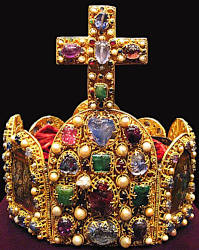
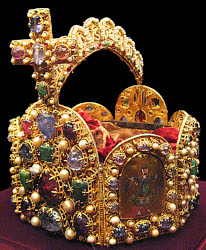
| Location: |
Hofburg, Schweizerhof, 1010 Wien.
U-Bahnlinie U3 bis Station Volkstheater. Straßenbahnlinie D bis Station Burgring/Kunsthistorisches Museum. (48.206999, 16.366133) |
| Open: |
All year Wed-Mon 9-17:30. [2025] |
| Fee: |
Adults EUR 16, Children (0-19) free, Students (-25) EUR 14, Seniors EUR 14, Disabled EUR 14. Audioguide EUR 5. [2025] |
| Classification: |
 Vault Vault
|
| Light: |
 Incandescent Incandescent
|
| Dimension: | |
| Guided tours: |
self guided.
Audioguide








|
| Photography: | allowed, with restrictions |
| Accessibility: | no |
| Bibliography: |
Manfred Leithe-Jasper, Rudolf Distelberger (2004):
The Kunsthistorisches Museum Vienna: The Imperial and Ecclesiastical Treasury,
Vienna: Scala Publishers. ISBN 978-3406429385.
Reprint: 2022, C.H.BECK. ISBN 978-3-406-59177-8.
online
|
| Address: |
Kaiserliche Schatzkammer Wien, Hofburg, Schweizerhof, 1010 Wien, Tel: +43-1-525-24-4409.
E-mail: |
| As far as we know this information was accurate when it was published (see years in brackets), but may have changed since then. Please check rates and details directly with the companies in question if you need more recent info. |
|
History
| 14th century | gold and silver utensils, coins, precious stones and jewellery, as well as the documents and insignia of the House of Habsburg stored in secure vaults next to the castle chapel. |
| ~1600 | a separate wing, the so-called "Kunsthaus", was built in the north-west of the Hofburg. |
| 1794-1800 | as a result of the Napoleonic Wars the insignia, jewels and vestments of the Holy Roman Empire relocated from Nuremberg and Aachen to Vienna. |
| 1806 | End of the Holy Roman Empire. |
| 1928 | reopened after World War I. |
| 1954 | reopened after World War II, Reichsinsignien returned. |
| 1983-1987 | comprehensive renovation of the treasury. |
Description
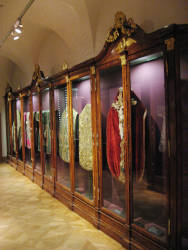
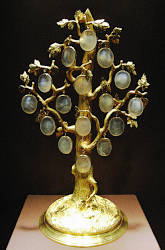
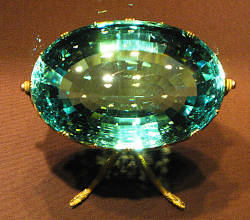
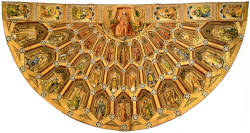
The Kaiserliche Schatzkammer (Imperial Treasury Vienna) is strictly speaking not underground, but it is definitely a vault. It is located in the Wiener Hofburg, the former residence in the city center. This vault is considered the most important treasury in the world. It contains two imperial crowns as well as the Burgundian treasure and the treasure of the Order of the Golden Fleece.
The crown of the Holy Roman Empire of the German Nation is the highlight of the collection.
The octagonal crown had high symbolic character and shows numerous biblical allusions.
It was created in the second half of the 10th century, and from this point the emperors of the empire were crowned with it.
It is one of the items of the Reichskleinodien (Imperial regalia) aka Reichsinsignien (Imperial insignia) or Reichsschatz (Imperial treasure).
The others are also here, der Reichsapfel (Imperial orb), the Heilige Lanze (Holy Lance), the Reichskreuz (Imperial cross), and the Reichsschwert (Imperial Sword).
They were stored from 1424 to 1796 in Nuremberg, before the imperial insignia had no fixed place of safekeeping and sometimes accompanied the ruler on his journeys through the empire.
When French troops reached Nuremberg on 9 August 1796, they were already relocated to Regensburg, remained in the monastery of St. Emmeram until 1800, and were then relocated to Vienna.
Due to the dissolution of the Holy Roman Empire, the Habsburg refused to hand them back.
Finally, they were returned to Germany by the Nazis before World War II, when they occupied Austria.
They spent the war years in Nuremberg, were exhibited in the Germanisches Nationalmuseum.
This story is told on the page
 Nuremberg Art Bunker.
Afterwards they were returned to Vienna, Nuremberg has copies.
Nuremberg Art Bunker.
Afterwards they were returned to Vienna, Nuremberg has copies.
The Holy Lance has some pop culture fame today. It is also known as the Lance of Longinus (named after Saint Longinus), the Spear of Destiny, or the Holy Spear. According to legend it was used to pierce the side of Jesus as he hung on the cross during his crucifixion. Later one of the nails with which Jesus was nailed to the cross was embedded. In Indian Jones it is one of the "magical" items the Nazis try to find, it plays a significant role in The Librarian: Quest for the Spear, Constantine, the series Legends of Tomorrow, and numerous computer games. That’s all nonsense, it was never lost, it is not magical, and it is actually much younger, it was created in Langobardian times, in the 8th or 9th century. At that time the production of fake relics was a flourishing industry.
The second important crown is the Austrian Imperial Crown, made in 1602 as a private crown for Emperor Rudolf II (*1552-✝1612). From 1804 it served as the crown of the newly created Austrian Empire, but no Austrian emperor was ever crowned with it.
The Burgunderschatz (Burgundy treasure) is from the 15th century, came into the possession of the Habsburgs with the marriage of Mary of Burgundy to the Archduke and later Emperor Maximilian I. The Order of the Golden Fleece was the highest-ranking order of the Habsburg monarchy, their treasure contains mostly religious items. The treasure contains art objects from the possession of Charles the Bold as well as regalia and chasubles with fine embroidery, which can hardly be imitated today.
Two objects were considered so unique in earlier centuries that they were declared unveräußerliche Erbstücke des Hauses Österreich (inalienable heirlooms of the House of Austria). The first is a huge Narwalzahn (Narwhal tooth), the tusk of a narwhale (Monodon monoceros). It was believed to be a unicorn horn and to have magical properties. The second is a late antique agate bowl, believed to be the legendary Holy Grail. It is one of numerous Holy Grails, and actually it is quite unlikely that Jesus, the son of a carpenter, owned such a rare and precious item.
 Search DuckDuckGo for "Kaiserliche Schatzkammer"
Search DuckDuckGo for "Kaiserliche Schatzkammer" Google Earth Placemark
Google Earth Placemark Imperial Treasury, Vienna - Wikipedia (visited: 11-JAN-2023)
Imperial Treasury, Vienna - Wikipedia (visited: 11-JAN-2023) Kaiserliche Schatzkammer Wien, official website (visited: 11-JAN-2023)
Kaiserliche Schatzkammer Wien, official website (visited: 11-JAN-2023) Index
Index Topics
Topics Hierarchical
Hierarchical Countries
Countries Maps
Maps